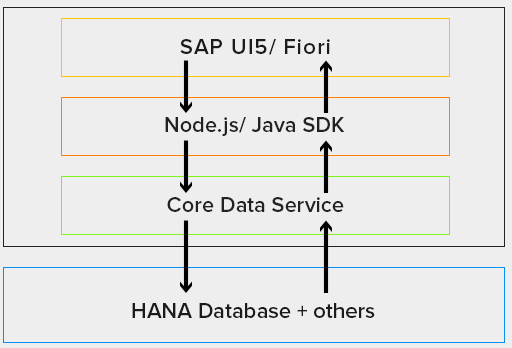Reading time: 5 minutes
Introduction
The world is going digital. It’s no secret anymore that more and more businesses are choosing to have their software delivered as a service and hosted in huge, secure data centers. In this software delivery changing process, the importance of simplicity can’t be understated. The number of applications, services or systems is constantly growing creating a much more complex world.
In order to meet a wide set of business criteria, an application or service is usually build at different platforms (such as SAP NetWeaver, SAP Web IDE) and using different languages (ABAP, CDS, UI5/Fiori).
This may raise a challenge: how to simplify a process of building enterprise-grade services and applications? SAP addresses this challenge with introducing the SAP Cloud Application Programming Model (formerly known as SAP CAP). SAP Cloud Application Programming Model removes the dependency on multiple platforms, thus focus on accelerated development and safeguarding investments in the rapidly changing world.
What is SAP CAP?
SAP Cloud Application Programming Model (CAP) is used to build cloud services within SAP. The SAP Cloud Application Programming Model is an open and opinionated framework of languages, libraries, and tools for building enterprise-grade services and applications. It leads developers through proven best practices and a great wealth of out-of-the-box solutions.
It uses Core Data Services (CDS) as an universal modeling language for both domain models and service definitions. However, in the real world, even a complex data model is not sufficient. A common business case require a business logic behind the model. The CAP framework offers Service SDKs and runtimes for Node.js and Java, offering libraries to implement and consume services as well as generic provider implementations serving many requests automatically. All this to make the implementation the easiest as possible.
On the top of that, SAP CAP Model provides out-of-the-box support for SAP Fiori and SAP HANA (HANA Cloud Database as the persistence layer). SAP offers a dedicates tools support provided in SAP Business Application Studio, Visual Studio Code and Eclipse. CAP model supports different synchronous protocols like REST, OData or GraphQL as well as many asynchronous channels and brokers like SAP Event Mesh, MQ or Kafka.
All of this is done in a smooth way, which requires minimal configuration. But despite of exposing of services, SAP CAP also provides a framework that allows you to consume other SAP BTP services in a seamless and safe way, therefore speeding up the whole process.
SAP Event Mesh is the default offering for messaging in SAP Business Technology Platform (SAP BTP). CAP provides out-of-the-box support for SAP Event Mesh, automatically and transparently handles many things behind the scenes. That makes the application coding agnostic and focused on conceptual messaging. This includes the following:
- Creation of queues & subscriptions for event receivers
- Handling all broker-specific handshaking and acknowledgments
- Constructing topic names (as expected by the message broker)
- Wire protocol envelopes (CloudEvents)
With a minimal effort, you can configure your application to consume messages as well as emit events to the specified queues of the binded SAP Event Mesh instance.
Use case
In the first article of this blog series by Andrzej you got an overview of how to expose your data in a fast and reliable way in real time using SAP BTP. In this scenario, every time a document is saved in S/4HANA system (in our case, this document is a Sales Order) the SAP Event Mesh distributes a message from S/4HANA to the integration platform (SAP Business Technology Platform). In consequence, an info about Sales Order with product details is saved in HANA Cloud database which is a persistence layer for a cloud-based service, which is a service build with SAP Cloud Application Programming model. As an effect, CAP service emits back an event to the SAP Event Mesh instance with information that order was saved in the database. An authorized user can access the data stored in HANA Cloud through CAP service at any time, from any place. You get an immediate notification with document info via messaging platform (i.e. Slack platform) using SAP Open Connectors. The API is securely exposed to the outer world by SAP API Management.
Summary
SAP CAP is a wise choice when you need to build enterprise-grade services and applications in a secure and open manner. The greatest advantage is the ability to use open-source languages and runtimes, including the capability to leverage third-party vendor libraries and the open-source community in general.
Read also:
1. Expose your data in a fast and reliable way in real time with SAP BTP
2. How to simplify your day-to-day operations with SAP Event Mesh




